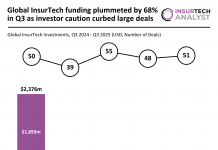The InsurTech sector for commercial insurance carriers has not evolved as quickly as expected, according to Joe Lettween, chief innovation, data science, and technology officer at Fortegra.
Lettween has a long-standing track record in innovation. Prior to joining Fortegra, he spent nearly a decade working within private equity, primarily in the realm of enterprise software. While working at Vista Equity Partners he led a team focused on value creation around technology, and data and analytics. The team worked with portfolio companies to explore how machine learning technology could improve value. During this time, Lettween worked with several players in the InsurTech space.
He later left Vista to help build a new private equity firm that focused on real estate, taking a two-year break from the technology world. However, when joining Fortegra in late 2022, he was surprised the InsurTech space had not advanced as anticipated. He said, “It’s been interesting to see that it hasn’t progressed for the commercial insurance space as much as you would have thought having missed an interim of many years.” This isn’t to say there has not been any development in the past three years, with Lettween pointing to the rise of generative AI and LLMs within insurance, but commercial insurance-specific solutions haven’t advanced significantly. “I’m sure I’m missing things and have not come across some things yet, but I’m not terribly impressed by what’s sort of out of the box available.”
There appears to be a major market for customisable solutions for areas like underwriting, workflows, policy and premium administration, claims management, and risk mitigation. Whether it is buying a software solution from Salesforce, ServiceNow or any number of other custom development shops, there are a wide range of options for insurers to rework a tool to help automate their workflows, he noted. But when it comes to pre-built point solutions that can be used out of the box, there are not many options. Lettween noted a lack of robust platforms in the market that address core insurance use cases, such as transaction systems, customer engagement, and claims processing. “It still feels like the insurance industry is trying to take from the broader landscape of financial services and back-office software and just pay money to customise it. I haven’t seen a ton of new offerings that are significantly different from that.”
Lettween believes this gap has manifested because one size doesn’t fit all, especially for the mid-to-large commercial sector. A company cannot just build their solution and jump from one insurance company to another, there needs to be a level of customisation so that it works for their specific environment and needs. He added, “There seems to be more uniqueness across firms that make it unattractive to have a consistent offering.”
The power of AI
AI has once again become the focal point of many business discussions. Spurred on by the hype around generative AI, companies are reassessing their operations and exploring how AI could revamp their workflows. The potential for generative AI has been well documented, whether it is for improving chatbot functions or helping generate insights from data.
One of the most exciting trends Lettween has noted is that AI is becoming easier for insurers to adopt. In the past, AI was often a large and complex technology stack that made it difficult to implement. For example, a firm could have trained their own models to automate document and policy processing, but it would have required a lot of internal resources. Whereas a firm, if it has the correct infrastructure, can now essentially flip a switch and implement an LLM into its software to automate these workflows.
“The good software vendors for the commercial insurance space will figure out how to integrate some form of LLM into their software, or the carriers will figure out how to do it outside of the core platforms, because it really does augment what the people are able to do in their processes.” For instance, by using AI, claims and customer support teams can improve efficiency, eliminating the need to pore over 150-page documents. It also ensures greater consistency across a team. Rather than having to train up each employee to ensure they all reach the same interpretation of the coverage policy, instead the LLM will just provide the single approved interpretation.
The role of Fortegra
Fortegra, which has been in the market for over 45 years, is a global specialty insurer, offering a variety of insurance products on an admitted and surplus basis. One of its defining features is that it is not just an insurer, by offering value-added services it acts as a true partner to MGAs and MGUs.
While the InsurTech sector might not have moved along as much as Lettween would have thought, it is still a highly competitive market and failing to evolve is often fatal. To stay relevant in the market, companies need to adapt to new trends and meet the evolving demands of customers. To that point, Fortegra is always looking at how it can improve its offering. Rather than looking at competitors and trying to “jump on the bandwagon,” the company has open dialogue with its clients to see what they actually need, he stated. Not all of this relies on implementing the latest AI tech stack, but could be smaller improvements, such as improving process flows or ensuring firms are getting the exact data they need for transactions.
With such constant engagement, Fortegra maintains an active pipeline for the coming years. Its data science team is currently laser focused on creating the next generation of tools for its MGA and MGU clients. On top of this, Fortegra is currently working on a platform that will sit across its transaction systems that will provide a more modern and flexible front-end that streamlines the implementation of tools. There are several other projects in the works, but one of note is a new mapping feature that would give clients the power to unlock new viewpoints on their data, helping them fully understand where their concentrations of risk are.
As to why an MGA should partner with Fortegra, Lettween said, “This is all we do. We are a specialty insurer focused on the program space across a couple of different sectors. We do both property casualty insurance and we also do warranty and service contracts. In those two spaces, there aren’t a lot of other players where that is 100% of their focus. You can go to some of the large insurers, and they may have some program business, but they aren’t focused on it, they do lots of things.”
There are some companies that look similar to Fortegra, but Lettween highlighted that these are often fronting carriers, which are taking very little risk. Fortegra, on the other hand, retains a substantial portion of the risk on its balance sheet and has a long history of managing it effectively. He concluded, “We are in business with them – we aren’t just producing business and passing on the risk. I think that makes us a better partner, because then we care about the program. We understand it, we want to get in business long-term, and we’ll help you be better.”










